How the LGM-118 Peacekeeper ICRM was protected and hidden
Threats and Responses
The development of the MX rocket started in the early seventies, and its creators immediately paid attention to the protection of ICBMs during service. Everyone understood that the enemy would recognize the coordinates of the silo launchers and would try to hit them with the first strike. A successful strike threatened to disable the key component of the US strategic nuclear forces. It was necessary to provide some kind of protection of the ICBM from the first strike and to save funds for a counterattack.
Due to the increased vulnerability of full-time silos at some point, the MX program was under threat. In the 1975-76 years, there were fierce disputes in Congress about the future of the new ICBM. Lawmakers did not want to spend money on missiles that could be destroyed by the first strike.
The military and industry, wanting to keep the program, offered and considered about fifty different MX deployment options with various features. A significant part of these proposals concerned the creation of improved stationary silos of various kinds. Provided for various options to strengthen the existing mines or the construction of updated reinforced objects. The possibility of camouflaging missile bases for other objects, including civil ones, was worked out.
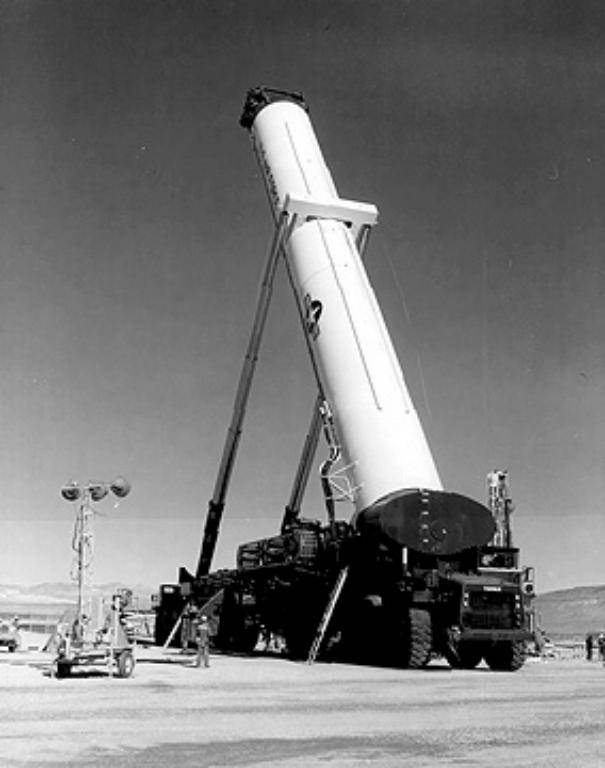
MX rocket on a transporter designed for use in the Racetrack system. Photo of Wikimedia Commons
An alternative was the placement of missiles on mobile platforms. Different variants of land and floating launchers were offered. Provided even launchers placed on airplanes and balloons. However, land or amphibious mobile missile systems looked most comfortable and promising.
On the ground and under the ground
In 1979, President J. Carter ordered the implementation of the Racetrack plan, which included new deployment principles for the MX ICBM. In Nevada and Utah, it was planned to build dozens of protected structures with launchers for missiles. With the help of a special transport between them, it was necessary to transport new types of ICBMs, making it difficult to track deployment processes. Protected start positions should be connected by surface roads and underground tunnels. However, this program was soon abandoned. It was overly complex and expensive, and besides, it did not guarantee the desired result.
Already under President R. Reagan, a new plan appeared. It provided for a deep upgrade of the silo from the LGM-25C Titan II to the needs of the new MX. Upgraded mines should have deployed up to hundreds of missiles. Other ICBMs were proposed to be placed on different platforms and carriers. For example, the possibility of building a silo on the southern slopes of the mountains was considered - they could be protected from military units of Soviet missiles flying through the North Pole. However, all these plans also did not receive approval and did not reach implementation.
In 1982, the MX rocket was named Peacekeeper (“Peacemaker”), and at the same time a project of positional areas such as the Dense Pack (“Dense Packing”) appeared. The project proposed the construction of ultra-secure bases, including several silos. The distance between the latter was reduced to 500-600 m. The ground parts of such structures had to withstand the pressure of a blast wave at the level of 70 MPa (690 atm) - five times more than the existing silos. However, from the "package" refused. With all the resistance of buildings, such a base could be destroyed with a coordinated blow. In addition, one rocket exploded could destroy the entire object.
On land and on water
None of the proposed silos could guaranteed protect the ICBM from the first strike of the enemy. In this regard, much attention was paid to mobile launchers that can move across large areas, literally moving away from enemy reconnaissance and destruction facilities.
By that time, the United States had an idea of Soviet developments in the field of mobile ground-based missile systems. Available data analyzed and made conclusions. The Pentagon considered that a multi-axle special chassis with a lifting container for a rocket has a number of drawbacks. A long chassis with a high center of gravity could have limited mobility. In addition, the Soviet samples had no serious protection. In this regard, the United States began to work out their own version of the special technology.
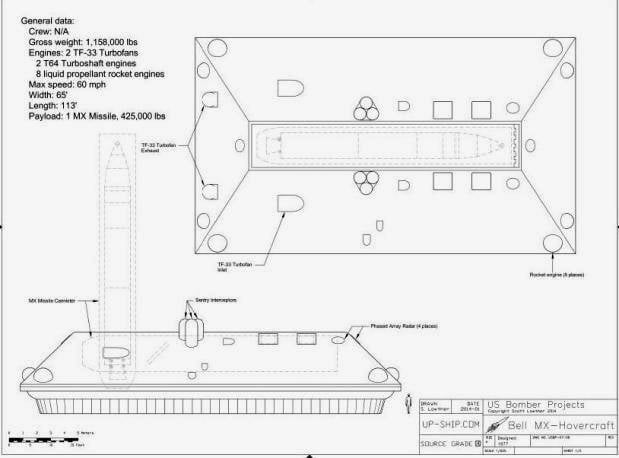
The diagram of the PGRK on the airbag from Bell. Figure Forums.spacebattles.com
It was proposed to create a special ground vehicle with a lifting device for the armored TPK. The possibility of constructing a PGRK on the basis of a hovercraft according to the type of projected LCAC was also considered. The use of a wheeled chassis made it possible to conduct combat patrols in remote areas of land, and the air cushion provided movement both on land and on water bodies.
An interesting variant of the PGRK for MX / LGM-118 was proposed by Boeing. Their launcher was a multi-axle armored vehicle of characteristic shape. It had an elongated shape and a trapezoidal cross section. Behind the cab and the engine compartment in the case there was a recess for laying TPK with a rocket. A similar pattern was protected from small weapons and could withstand the damaging factors of a nuclear explosion at certain distances, while maintaining performance. Thus, under normal conditions, the PGRK from Boeing could simply reach the position and launch, and, if the reconnaissance and the enemy missiles were successful, survive the attack and send their missile to the target.
A bolder project PGRK worked out by Bell. She proposed to place the rocket on a self-propelled air-cushioned vehicle, which provides high mobility on different surfaces. Such a machine was made in the form of a truncated pyramid with a length of more than 34 m; in its highest part under the armored hatch fit the WPK with ICBMs. The mobility was provided by a set of turboshaft lifting and turbojet propulsion engines. Also included liquid rocket engines for "jumping" through obstacles.
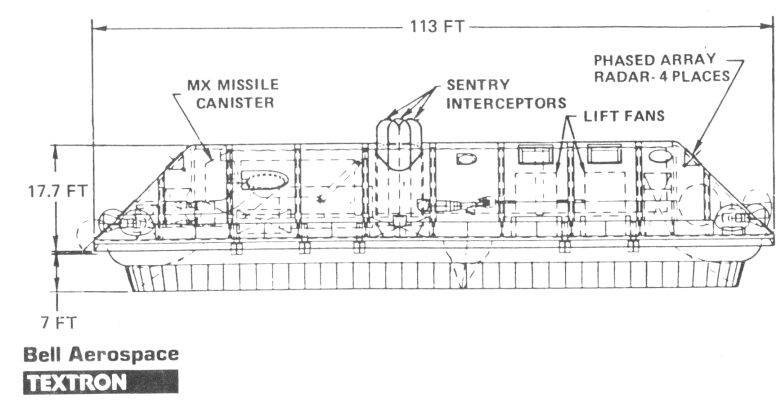
Layout self-propelled launcher on an air cushion. Figure Forums.spacebattles.com
Bell survivability of the PGRK from Bell was provided with combined protection comparable to 900-1000 mm of homogeneous armor. It was also planned to equip the complex with its own missile and artillery defenses. PGRK of this type should have been located in protected structures in deserts or tundra and, on command, set out on a route. The project provided for the rejection of the crew in favor of advanced automation, capable of performing all tasks.
The final two projects PGRK obvious. Bell's proposal was considered too complicated for practical implementation, and the Boeing project could count on development. However, it was not very successful either. After part of the work, it was also closed due to excessive complexity.
Railway rocket
At the end of 1986, the development of a new version of the mobile ground complex began, which should have been less complex and expensive. Launcher and related equipment offered to put on a special train. The project of a combat railroad missile complex was designated Peacekeeper Rail Garrison.
The new BZHRK was supposed to include two locomotives, two carriages-launchers with one LGM-118 rocket each, a carriage with a control post and several carriages for personnel, fuel and various auxiliary equipment. The crew of the complex should have included a 42 man. They could carry continuous duty for a month. Some components of the Peacekeeper Rail Garrison BZHRK had to be developed from scratch, while others were taken ready.
In October, 1990, the Peacekeeper Rail Garrison test complex, was put to the test. Checks and tests on landfills and railways of the general network lasted for several months and ended with good results. Despite the presence of certain problems, the prototype showed itself well and confirmed the fundamental possibility of operating BZHRK.
However, in 1991, the confrontation between the superpowers finally ended, and a number of promising weapons turned out to be unnecessary. In particular, the threat to the ground component of the US strategic nuclear forces was sharply reduced, which made it possible to reduce or close part of new projects. The BZHRK Peacekeeper Rail Garrison project fell victim to these cuts. In 1991, it was stopped and has not been resumed since.
Back to the mine
The LGM-118 Peacekeeper performed the first test flight in June of the 1983. At the end of the 1986, the first production missiles were deployed on standard launchers. Over the next few years, several units of the Strategic Command of the Air Force were transferred to these ICBMs.
By the time the missiles were put on duty, industry and the military did not have time to complete the development of new home-based equipment, which led to known results. The new MX / Peacekeeper missiles were housed in modernized mine launchers from the LGM-25C Titan II and LGM-30 Minuteman ICBMs. Also built new silos, but they repeated the design of existing ones. Fundamentally new objects like those previously proposed were not built. Any mobile missile systems also did not enter the series and did not get into the army.
By the beginning of the two thousand years, the number of deployed ICBMs LGM-118 decreased and did not exceed several dozen. At the beginning of the 2005 of the year, only 10 of such missiles remained on duty. 19 September 2005-th held a ceremony of their decommissioning.
The intercontinental ballistic missile LGM-118 Peacekeeper has been in service for almost two decades and was operated only with silo launchers of the "traditional" appearance. All attempts to develop fundamentally new means of basing - both stationary and mobile - were unsuccessful. However, the Pentagon did not abandon such ideas and initiated the development of new mobile missile systems.
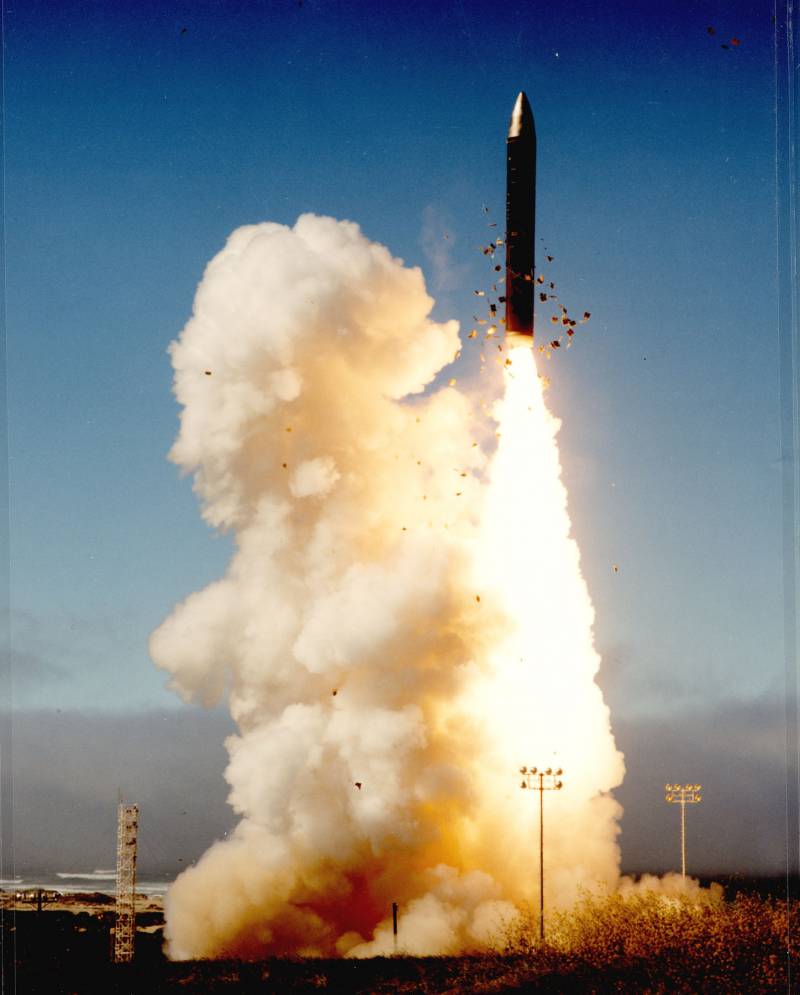
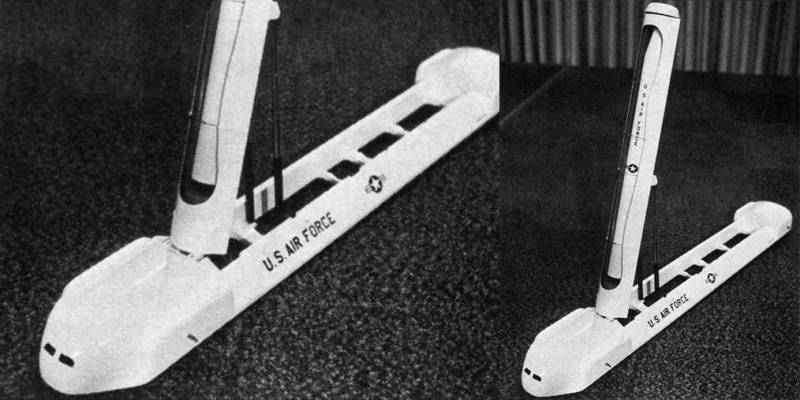

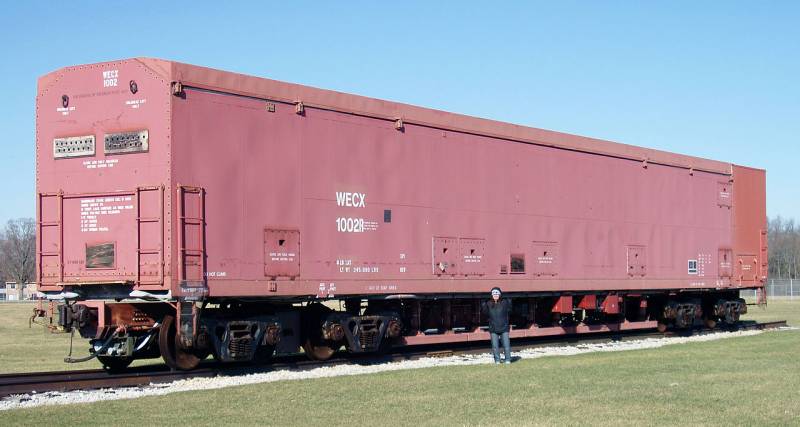
Information